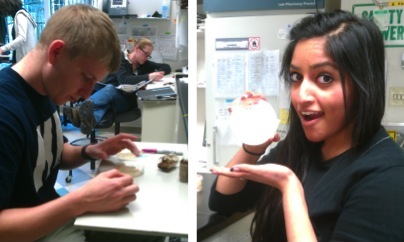Bio 482 Highlanders

Fig: Working hard in the Malik Lab at The Fred Hutchinson Cancer Research Center
Research Description
In most eukaryotic organisms, sexual reproduction is a critical component of the life cycle. Through meiosis, diploid cells containing two copies of each chromosome divide to produce genetically diverse haploid gametes (e.g. sperm) that contain one copy of each chromosome. This process is fundamental in sexual reproduction. Generally, meiosis results in a 50:50 transmission of heterozygous alleles into gametes. Because only one copy of each chromosome can contribute to a given offspring, there is an evolutionary pressure on alleles to compete for preferential inclusion in gametes. Sometimes alleles can “cheat” to gain a greater than 50% expression through meiosis. This is known as meiotic drive. Meiotic drive could have significant implications: altering fertility, speciation, and the evolution of chromosomes in eukaryotic organisms. For example, competition between alleles may be driving the rapid evolution of chromosome segregation factors acting during meiosis and mitosis, potentially driving chromosome segregation away from a theoretical ideal. Though meiotic drive has not been well understood due to limited model systems, in the Malik lab we have developed a novel system utilizing genetically tractable fission yeast S. pombe and S. kambucha, to investigate meiotic conflicts between competing alleles. In S. pombe, heterozygous alleles are widely thought to segregate fairly in meiosis, suggesting that active meiotic drive loci are not present in this organism. However, recent work in our lab suggests that cheating loci are present, but silenced. We will test the hypothesis that aging germ cells, undergoing several rounds of mitosis prior to meiosis, will de-repress silenced meiotic drivers. This will provide experimental evidence in support of the evolution of cheating in meiotic processes that could ultimately result in decreased fertility rates amongst eukaryotic organisms, including humans.
Back to Biology 482 Homepage